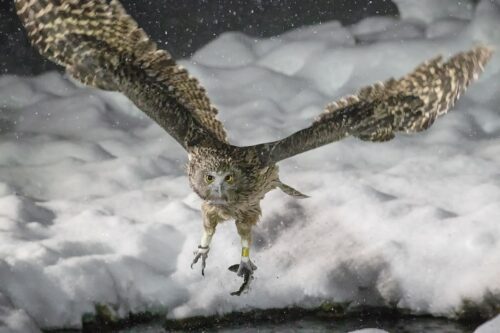It has fierce yellow eyes and lives in the trunks of massive, old-growth trees. When the bird takes flight, it can have a wingspan of over six feet. During its breeding season, its calls are so in sync with its mate’s that novices often believe only one bird is hooting. Blakiston’s fish owl is the largest living species of owl, dwelling in parts of Japan, China, and far east Russia. Members of the species are difficult to find, especially as loggers destroy their habit year over year.
Jonathan Slaght has spent his career researching this majestic creature and fighting to conserve its habitat. In his book Owls of the Eastern Ice, Slaght narrates his fieldwork in Primorye, east Russia, searching for the owl. Beyond the story, he also discusses conserving habitats and cross-cultural science. The result is an engaging read of crusades through snow and ice.
The book’s events take place over a period of four years, beginning with the start of Slaght’s Ph.D. project. Blakiston’s fish owls are easiest to find in the winter, so every time the cold months come around, he leaves Minnesota for Russia. The book follows his extensive quest through the snowy wilderness to find, trap, and then tag the fish owls—his ultimate goal is to use GPS information to decipher the owl’s preferred habitat and determine what areas to protect.
Finding and trapping is a convoluted process; the birds are rare and avoid many traps Slaght’s team devises. Eastern Russia is harsh and unforgiving. Slaght recounts being wet to the bone, trudging through snow for hours, sleeping in unforgiving conditions, and even a dramatic sequence of events where he sits in a tractor being carried along a roaring, overflowing river.
Slaght also faces the difficulty of doing field research in a foreign land. While Slaght is fluent in Russian, Primorye sees few visitors, and many are shocked to learn that he is an American and studying owls, no less. He talks seriously of lasting Cold War difficulties and counters that wildlife sees no borders. His Russian coworkers seem outlandish to an American reader. Sergey, his most frequent assistant, has “an upper row of gold teeth perpetually clenching a cigarette.” Slaght recounts how his colleagues make fun of him often—for not knowing how to hold his vodka, for failing to drive a snowmobile correctly, for wearing fancy outdoor gear, and more. Despite this, he’s fond of them all. Through his descriptions of his friendships, Slaght makes a strong argument that science knows no borders. After all, wildlife doesn’t: salmon that the fish owls hunt are eaten all over Asia, and wood from Primorye forests goes to North America.
Despite the difficulties he faces, Slaght’s passion for his job leaks out of every sentence. Even as Slaght campaigns for conservation and international collaboration, Owls of the Eastern Ice is ultimately about loving fieldwork. “I was truly comfortable here, alone among the trees, breathing in the cold air and passing familiar landmarks,” Slaght wrote about returning to Primorye one year.
Overall, Owls of the Eastern Ice is a worthwhile read, both for Slaght’s thrilling adventures and for a deeper understanding of conservation biology.
Slaght, J. C. (2020). Owls of the Eastern Ice. S.l.: Penguin Books.

